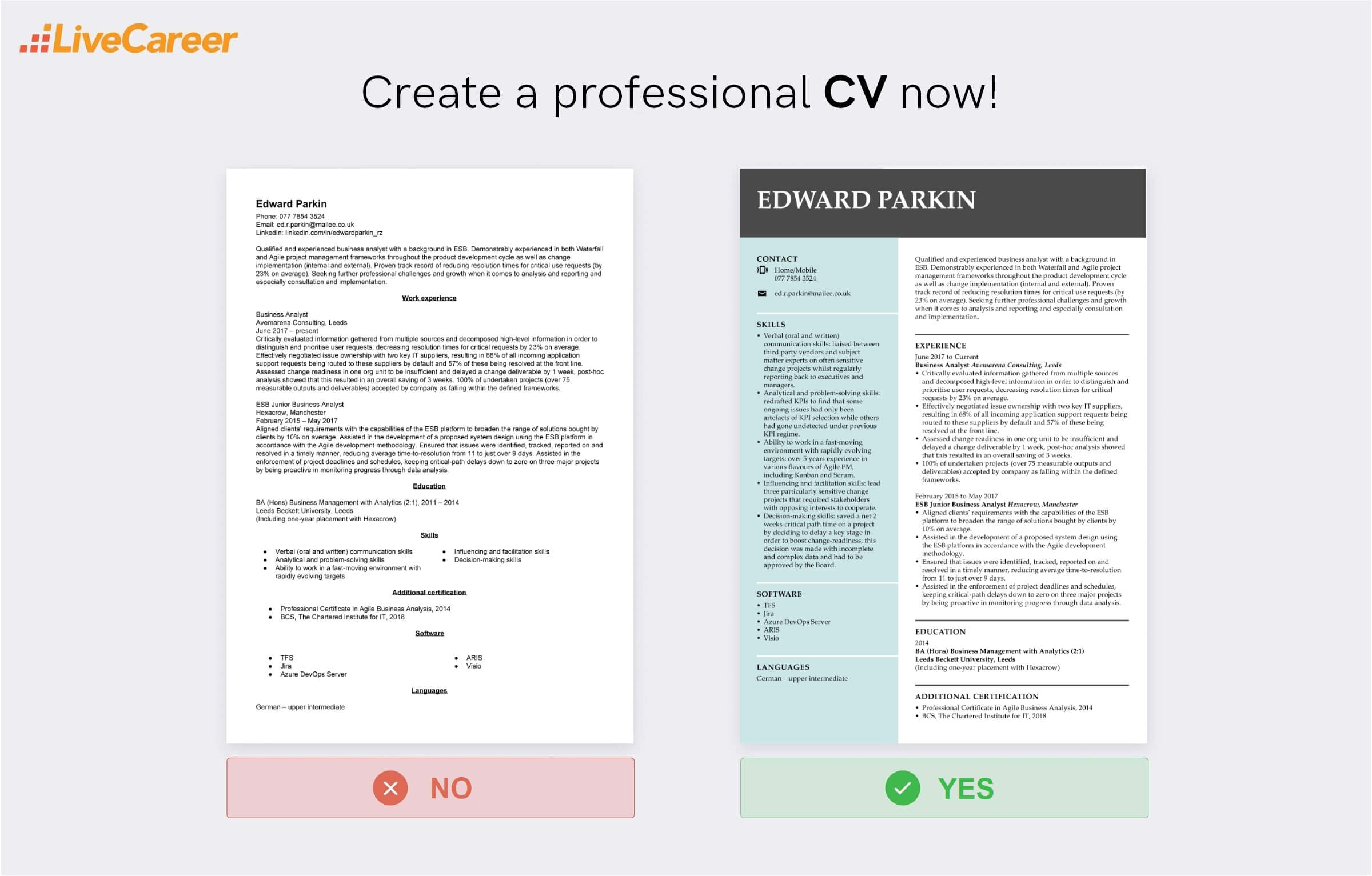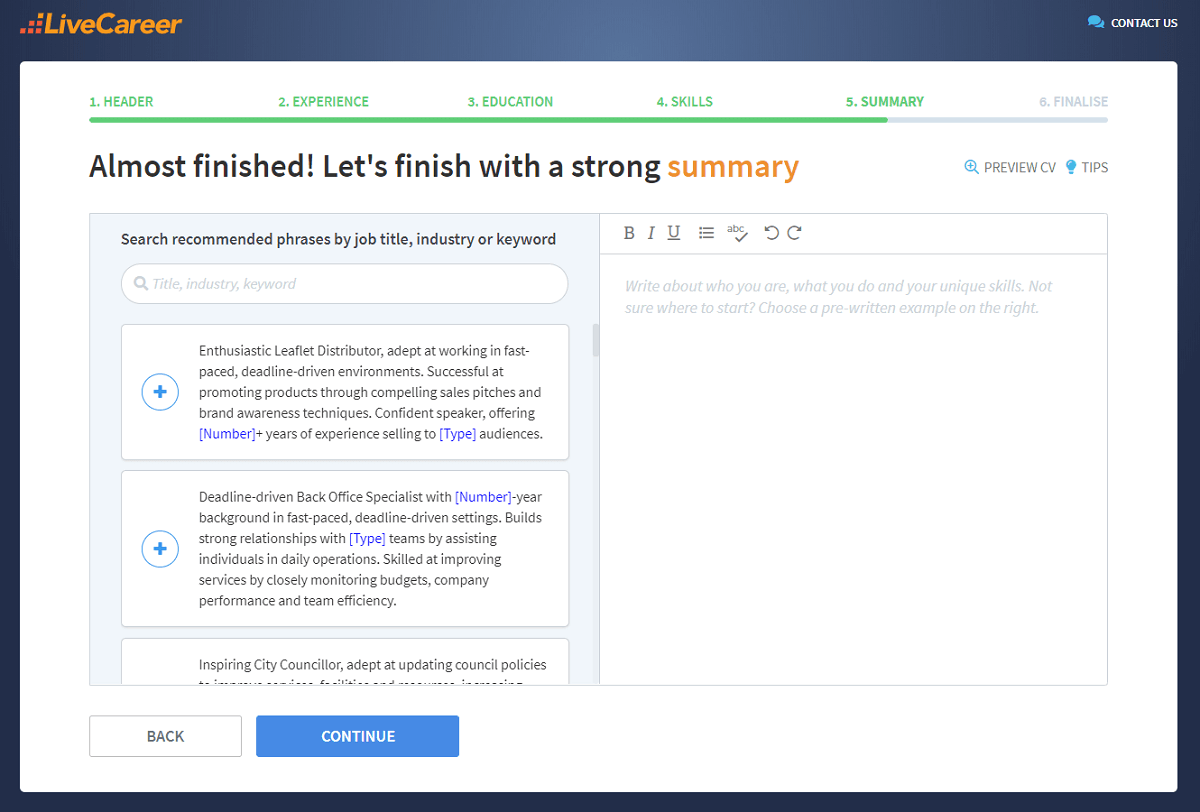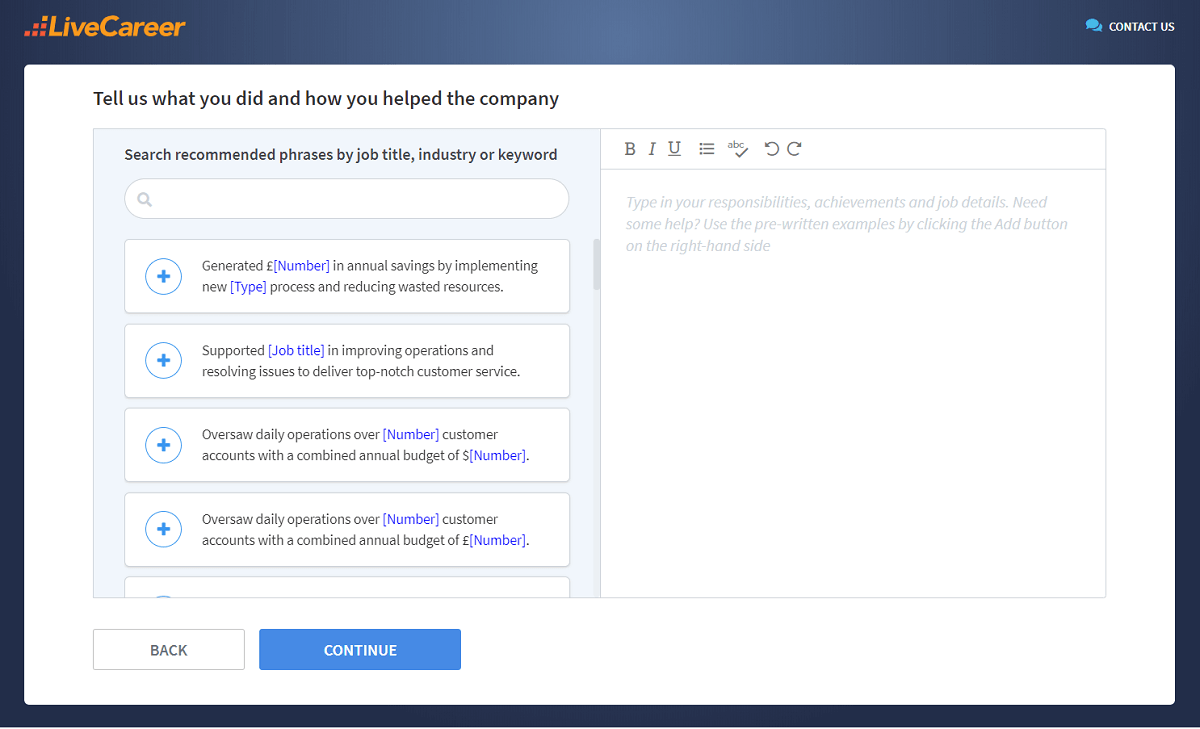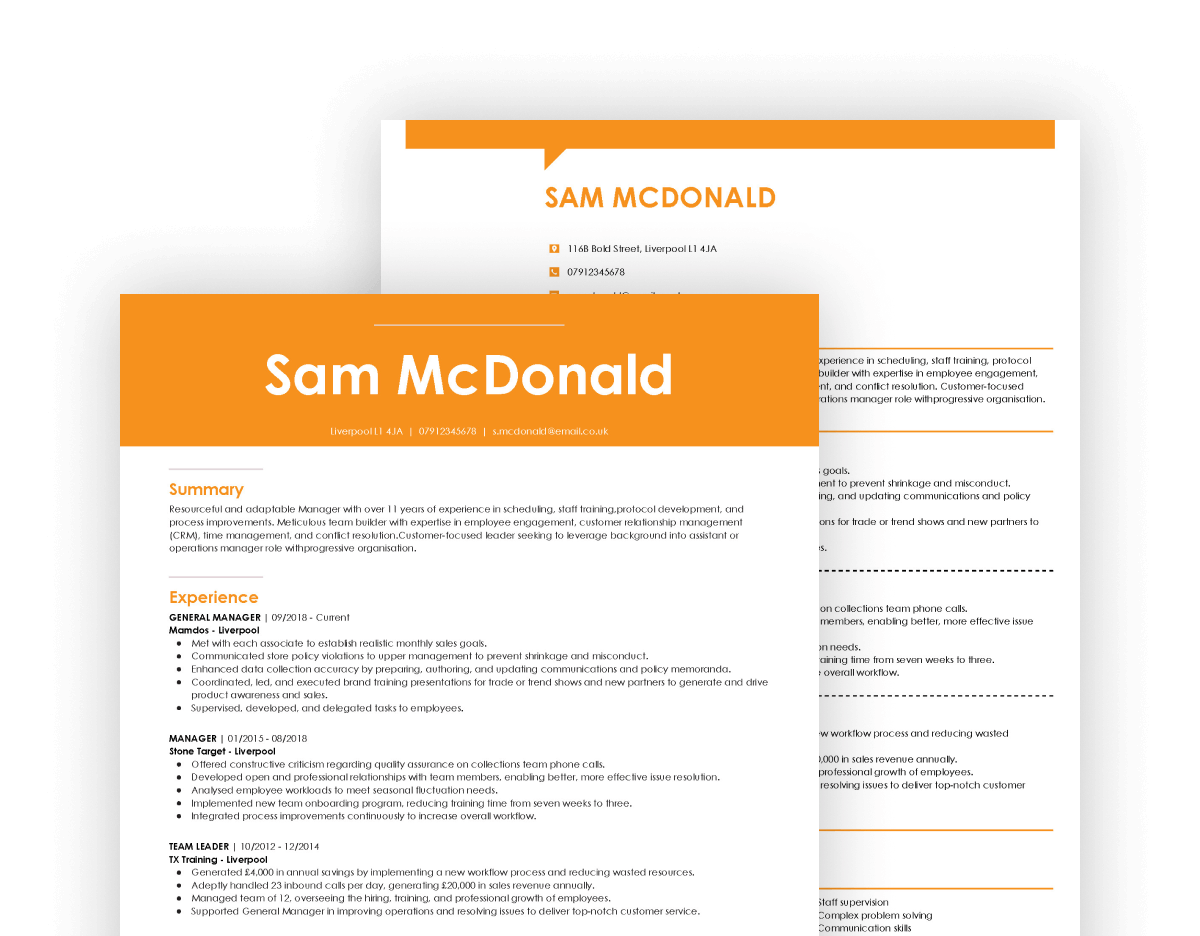Resume vs CV: Key Differences + Examples [2025]
Resume vs CV. What are the differences between them? Is their format any different? And which one should you use in the UK? Check the answers here.
Our customers were hired by:
The world of business analysis can be complex and jargon-filled. Your task then becomes to logically organise and persuasively present complex, technical data to a varied audience. Luckily, this is at its core what a BA does. This guide is here to help you bring your skills to bear on something that might be standing in the way of your success – your business analyst CV.
Create an effective CV in minutes. Choose a professional CV template and fill in every section of your CV in a flash using ready-made content and expert tips.

We created the sample on the right using our builder. See other good CV examples like this one.
Need a different CV example? Check these samples:
Haven't found what you're looking for? Check all our CV examples.
Based on over 6 million CVs created in our builder, we found out that*:
*The data comes from a period of the last 12 months (August 2023-August 2024).
Edward Parkin
Phone: 077 7854 3524
Email: ed.r.parkin@mailee.co.uk
LinkedIn: linkedin.com/in/edwardparkin_rz
Qualified and experienced business analyst with a background in ESB. Demonstrably experienced in both Waterfall and Agile project management frameworks throughout the product development cycle as well as change implementation (internal and external). Proven track record of reducing resolution times for critical use requests (by 23% on average). Seeking further professional challenges and growth when it comes to analysis and reporting and especially consultation and implementation.
Work experience
Business Analyst
Avemarena Consulting, Leeds
June 2017 – present
ESB Junior Business Analyst
Hexacrow, Manchester
February 2015 – May 2017
Education
BA (Hons) Business Management with Analytics (2:1), 2011 – 2014
Leeds Beckett University, Leeds
(Including one-year placement with Hexacrow)
Skills
Additional certification
Software
Languages
A business analyst CV is a brief document that highlights your key qualifications and skills for the business analyst job. It should show you are familiar with how organizations work and that you've successfully improved them in the past.
Usually, it's one page long, formatted into proper sections, and is sent alongside a business analyst cover letter.
Now, here's how to write your business analyst CV, with expert business analyst CV examples included:
The first thing in your business analyst CV, after your personal details, should be your personal statement. Also known as a personal profile, your personal statement is a direct answer to the questions on every recruiter’s mind: who is this person and what can they bring to my company?
Answering those questions is a perfect way to write your personal statement. There’s just one more question you should add to round out the statement. All up, you should aim to answer the following in about 50-150 words—3-4 sentences in total:
You should write a new personal statement for every job application. Use your personal statement to show that you’re a perfect match for the job on offer.
This section goes first, but it’s best to write it last. It’ll be much easier once you have a master list of skills and a full employment history in front of you (that's why it's also known as a CV summary). It’s important to have it in the back your mind from the beginning, though.
One last thing to look out for: when choosing relevant skills for your business analysis CV personal statement, use the same keywords as those in the job advert. Many companies will use an Applicant Tracking System (ATS) to sort CVs by relevance and recruiters will also be scanning for relevant keywords.
Qualified and experienced business analyst with a background in ESB. Demonstrably experienced in both Waterfall and Agile project management frameworks throughout the product development cycle as well as change implementation (internal and external). Proven track record of reducing resolution times for critical use requests (by 23% on average). Seeking further professional challenges and growth when it comes to analysis and reporting and especially consultation and implementation.
A strong CV summary will convince the recruiter you’re the perfect candidate. Save time and choose a ready-made personal statement written by career experts and adjust it to your needs in the LiveCareer CV builder.

Tackle this section first. Writing your work history won’t be the easiest part of writing your business analyst CV, but it will bring you the greatest ROI. Don’t omit this section, even if you’re writing an entry-level business analyst CV. If you have no work experience at all, then consider writing a student or graduate CV instead.
Stick to a chronological CV format. Start with your most recent experience and work your way back from there. This is by far the most common format, it’s what recruiters and hiring managers are used to seeing. It’s also what ATSs are designed to parse most easily.
Although Curriculum Vitae stands for 'course of life', include only relevant work experience. Don’t just list your duties. Give concrete examples of your competencies. Quantify your achievements and impacts as much as possible. Don’t try to put a spin on things, let the facts speak for themselves. Aim for up to six bullet points.
Start each bullet point with a CV action word, like assessed, ensured, achieved, or negotiated. Consider using the SAR (Situation, Action, Result) framework. It’ll make the process much easier. Try to use accomplishment statements rather than responsibility statements.
Business Analyst
Avemarena Consulting, Leeds
June 2017 – present
ESB Junior Business Analyst
Hexacrow, Manchester
February 2015 – May 2017
This is the easiest section, but attention to detail is no less important here than elsewhere. Once again, use a chronological format, work from most to least recent. Follow the business analyst CV template to keep the layout clear.
If you have BCS/ISEB certification (or equivalent) or the BCS International Diploma in Business Analysis, then you can include it here or in an additional section.
There’s usually no need to mention secondary school once you’ve got your university degree. If you’re writing an entry-level or junior business analyst CV, then you may consider adding your A-levels and GCSEs. Still at university? Then include your expected graduation date.
For university degrees, include the university name, the name of your degree, and the years attended. If you are going to include your high school education, then include the name of the school, its location, and the years you attended.
List all three A-level subjects but just include the number of GCSEs you completed without listing them individually. It’s often a good idea to mention Mathematics and English in your GCSEs, though, as many employers will be on the lookout for these as a minimum.
If you’re a recent graduate or school-leaver and don’t have much experience, then place this section ahead of your work experience section. You can also list some extras here such as extracurricular activities.
BA (Hons) Business Management with Analytics (2:1), 2011– 2014
Leeds Beckett University, Leeds
(Including one-year placement with Hexacrow in Manchester)
Being a business analyst requires a complex set of skills. Not all of these skills will be obvious or even readily understandable by the first person who picks up your business analyst CV. Analysis, monitoring, prediction, these things are suggested by the job title, but there’s so much more to it than that.
You’ll be tailoring this section to each job offer. Begin with a master list of skills from which you’ll be able to draw for each application. Include hard (technical) and soft skills. It can be hard at first but don’t worry—it snowballs once you get going.
Bring up the job advert to which you’re responding. Check what skills they list there. Compare your list with theirs. Identify the matches and choose 5-10 of them for your business analyst CV. Try to keep a good balance between hard, soft, and IT skills—they’re all important.
Now, don’t just make a list of skills. Anyone can come up with a list of vaguely-defined but impressive-sounding BA skills. Stand out by adding one sentence to each skill that shows how you demonstrate that skill in action. Once again, be concrete and be specific.
You have all the basics covered: work experience, education, skills. You’ll soon have your personal statement sorted. The problem is that everyone has those sections. Yours will be better than most, and that’ll help, but you don’t want to pass up an opportunity to stand out wherever you can.
Add extra sections to your business analyst CV to really personalise your application. The other sections will capture 90% of who you are as an employee. Fill out the other 10% for a fuller picture. You could mention additional qualifications, achievements, awards, even hobbies (avoid listing references on your CV, it's old fashioned). Just keep it relevant to your job.
Do you have any IIBA certificates? What about PMI or BCS qualifications? An extra section that showcases just these additional certifications is a great way to grab a recruiter’s attention. Treat them similarly to university degrees: include the name of the qualification/certificate, the year/s attended, and the name of the awarding body.
Additional certification
Software
As a business analyst you appreciate the significance of proper documentation better than most. A cover letter remains one of those formalities that you shouldn’t forego lightly. Include a cover letter with your business analyst CV unless you’ve been specifically asked not to.
It’s no secret that formal cover letters (actual letters) are going the way of the hand-drawn Gantt chart, but just over half of employers still prefer candidates to include a cover letter. You have everything to gain by including a cover letter and nothing to lose.
Start by using the right cover letter format. Once you have the formalities out of the way, grab your reader’s attention with a strong opening—lead with an impressive professional achievement. Showcase your skills and experience as a BA. Close your cover letter with a call to action: an opportunity to discuss your candidature further.
Business analysts are very familiar with the importance of presentation. By now, you’ve put considerable effort into presenting the information in your business analyst CV as clearly as possible. Look after that investment of time and energy by seeing to aesthetics and optics.
Stick to some basic CV layout rules:
Proofread—check for spelling and grammar mistakes and make sure both your CV and cover letter are clear and easy to read. Ask someone else to read and check through them as well. Make use of any of the apps, web apps, or programmes out there that can help you with spelling and grammar. It’s incredibly important that you have everything word-perfect.
One last CV tip: you should definitely avoid using ‘Please find attached my CV.’ when sending in your job application. 'I’ve included my CV below." sounds more like the XXI century.
Congratulations, now you know what a CV should look like. You’ve dramatically improved your chances for success!
You don’t have to be a CV writing expert. In the LiveCareer CV builder you’ll find ready-made content for every industry and position, which you can then add with a single click.

Has this guide been helpful to you? Do you have any questions on how to write a BA CV? Please leave me a comment below if you do! These are interesting and challenging times to be a business analyst—I hope this article helps you get the job you’ve always wanted.
Our editorial team has reviewed this article for compliance with Livecareer’s editorial guidelines. It’s to ensure that our expert advice and recommendations are consistent across all our career guides and align with current CV and cover letter writing standards and trends. We’re trusted by over 10 million job seekers, supporting them on their way to finding their dream job. Each article is preceded by research and scrutiny to ensure our content responds to current market trends and demand.
About the author
Since 2013, the LiveCareer UK team has shared the best advice to help you advance your career. Experts from our UK editorial team have written more than one hundred guides on how to write the perfect CV or cover letter.
Rate this article:
Business analyst cv
Average:

Resume vs CV. What are the differences between them? Is their format any different? And which one should you use in the UK? Check the answers here.
See when to use a skills based CV and how to write it for the UK job market. Learn from the free skills based CV examples and download a functional CV template.
Looking for a blank CV template? Check our comprehensive list where career experts have picked the best blank CV templates for the UK job market.
Our customers were hired by: